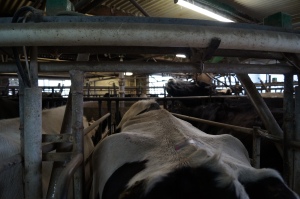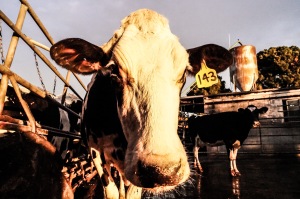An unfortunate reality of farming is that sometimes we lose stock. There are various videos and articles floating around the internet which portray this phenomenon in a less than tasteful or transparent way. Obviously there are various animal rights groups who have a barrow to push claiming that farmers torture and ‘murder’ their animals, subjecting them to pain and fear as yet unappreciated by the general populace, and that it’s their job to name and shame the perpetrators. As a farmer, I’m not about to stand up and defend every single other farmer on the planet’s practices. There are ‘cowboys’ out there who are, to say the least, unprofessional and cruel and if I ever saw somebody carrying out an act of abject cruelty to any animal, I’d report them myself and be damned by the consequences to me personally. But to make a broad and sweeping generalisation which tars all of us with that same brush is like saying that every doctor on the planet has deliberately or through negligence killed some of their patients; or that every accountant in the land has robbed their clients of their hard earned cash through weasely practices and loopholes, or that every single greenie is some smelly druggie hippy who dropped out of art school – it just isn’t true.
I get really down when I lose stock and I get really pissed off when I see ARA’s showing footage of practices that they have clearly either staged or taken completely out of context (in many instances); it feels like a personal attack on my abilities to care for my animals. A farming friend once told me, whilst I was in the throes of beating myself up over a dead cow, that “where there’s livestock, there’s dead stock”. While it didn’t make me feel any better (cheesy platitudes rarely do) it did make me think that he had a really good point.
I pride myself on my knowledge of cow health issues. Give me an examination glove, a stethoscope, a thermometer, and some urology strips and I can diagnose about 95% of any of the common ailments my cows will get, just as well as any vet. In some cases, better than a vet, but alas I am not trained, nor licenced to perform surgery if I diagnose an ailment which requires it and nor am I allowed to carry the anaesthetics I would require to do so. Obviously, in any animal health case, the first and preferable option is to prevent animals from getting sick in the first place; nutrition is a massive factor in dairy cattle as they are, despite being big and robust animals, quite fragile in the gastrointestinal department particularly just before and just after calving. Getting the feed right is absolutely critical. Ensuring they’re comfortable is also a biggie, and a massive challenge for outdoor farms like ours where cows are out on pasture 365 days per year, in some cases in quite extreme weather conditions. So what can we do then? Well, tree breaks offer shelter from the elements in both summer and winter, so we ensure we have them in every paddock. Our cows also have to walk a lot, so for us, winter is a massive challenge when the weather is wet as the fine particles on the compacted laneways get washed out, exposing the gravel underneath. Cows who have wet feet all the time get soft hooves, so when the little rocks on the laneways get exposed, it hurts their feet when they walk. Again, we don’t want ‘footsore’ animals so we go out of our way to soften the laneways. Some people use river sand, some use bark chip or peelings and we personally roll out tonnes and tonnes of hay for them to walk on, all by hand I might add, which adds a huge amount of work to an already long day, just to provide a bit of creature comfort to our animals. And we aren’t the only ones who do this either. No dairy farmer that I have ever met wants to see their cattle wincing their way up the laneway to their paddock on sore feet; it’s like making a person take off their shoes and walk across a hard surface littered with broken glass. Painful for them, and painful to watch.
Anyway, getting a little off topic there, so I’ll carry on with my original thread; deadstock.
This morning was my midweek morning off. Since I am currently working 15 hours per day, 7 days a week, I feel I’m entitled to catch up on some rest from time to time, so don’t judge me. Three days ago, I had a cow come in for milking who was, as we say in the business, “off her milk” (that is to say, a normally good milker will come in with, well, little or no milk). Cows can go ‘off their milk’ for any number of reasons including something as benign as being on heat for example, but generally it’s something fairly major; a massive pyometra (uterine infection) or urinary tract infection for example, or it could be mycotoxin poisoning from a water damaged batch of grain, or they may have picked up a dose of pneumonia or salmonella, or any other of a host of nasties that we sometimes get outbreaks of due to a bad load of hay, some nasty weather or some other extraneous factor.
Needless to say, despite being fairly confident in my diagnosis of my crook cow, I called the vet in to do an examination. He diagnosed her as having a, probably viral, urinary tract infection and a slight cold and told me to stop treating her with antibiotics as she was clearly fighting the infection off herself and the antibiotic I was using would be of no further benefit. I was less than convinced by his diagnosis as a whole and carried on with her treatment as I was sure that there was something else going on as well.
The following day, a second cow came in with exactly the same symptoms. I put her on treatment immediately. So two days ago I had two sick cows in my hospital paddock. This morning, whilst enjoying my second leisurely cup of coffee, I received a phone call from my relief milker telling me I had two dead cows in my hospital paddock.
With a sick feeling in my chest, I immediately rang the vet and asked him to come out and do a necropsy (you may well think that’s like closing the stable door after the horse has already bolted, but sometimes it’s necessary to prevent further losses). I rang my boss to tell him what was going on, then went down to oversee the proceedings. The results: one case of pneumonia and one case of salmonella. Was I treating the animals with the appropriate drugs? Yes. Could I have prevented them from getting sick? No. Can I prevent any other animals from picking up these bugs? No. Nothing I do will stop my cows from getting sick with these diseases. Yes, you can vaccinate for salmonella, but which strain should we pick to vaccinate against as there are literally hundreds of strains which are constantly mutating? And if I treat them, are they not responding to that treatment because the strain I am trying to fight is resistant to that particular drug? So many doubts and fears creep in at this point – the sinking feeling in your gut when you see another cow come in with similar symptoms – can I save this one? CAN I do something better/differently?
If you’ve never worked with stock and you feel that we are negligent or cruel to our animals because you watched a video on YouTube once, remember this; No real farmer would want to see their animals stressed in such a way that it affected yield or quality of the end product, be it meat, milk or wool. No real farmer can justify losing animals through negligence because they are how we make money, at the very least, and the vast majority, amongst whom I definitely count myself, don’t want to see their animals suffer in any way. Bear in mind that most livestock farmers live in fairly isolated places. Our stock are, much of the time, our only company for days or weeks at a time. Every time we lose an animal, it’s personal. And every time a new ARA video comes out, it’s personal too, even if it’s not depicting us personally.
And remember also; animals, like people, sometimes just die for no immediately apparent reason. So like my friend told me: Where there’s livestock, there’s dead stock.

